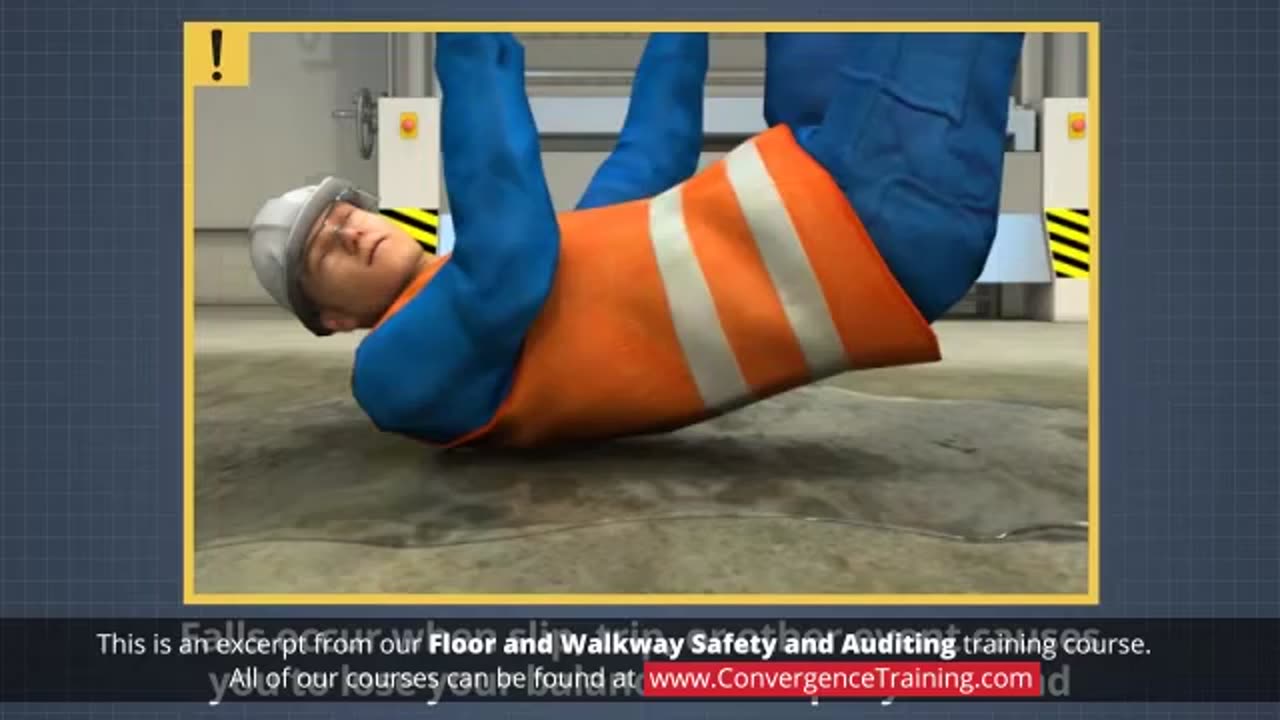Premium Only Content

Floor and Walkway Safety and Auditing Training
### **Floor and Walkway Safety and Auditing Training**
This training focuses on teaching participants to identify, assess, and address floor and walkway hazards, ensuring safety in workplaces, public areas, or private spaces. It’s essential for supervisors, facility managers, safety officers, and anyone responsible for maintaining safe environments.
---
### **Training Objectives**
1. Understand common causes of slip, trip, and fall incidents.
2. Learn methods to inspect and audit floor and walkway safety effectively.
3. Implement preventive measures to minimize hazards.
4. Train staff on best practices for maintaining safe walking environments.
---
### **Key Training Modules**
#### 1. **Understanding Floor and Walkway Hazards**
- **Types of Hazards**
- Slippery surfaces: water, grease, oil, or spills.
- Uneven surfaces: cracks, loose tiles, or transitions.
- Obstructions: clutter, cords, or debris in walkways.
- Environmental factors: poor lighting, glare, or shadows.
- **Statistics and Impact**
- Common workplace injury statistics (e.g., OSHA or HSE data).
- Financial and productivity losses due to incidents.
---
#### 2. **Inspection and Auditing Techniques**
- **Tools and Equipment**
- Use of slip meters to measure floor friction.
- Flashlights, checklists, and cameras for documentation.
- **Inspection Process**
- Assess flooring materials for slip resistance.
- Identify high-risk zones (kitchens, entrances, bathrooms).
- Evaluate lighting levels, drainage systems, and signage.
- Check maintenance records and incident reports.
- **Creating an Audit Checklist**
- Include essential items (e.g., surface conditions, housekeeping practices, presence of signage).
- Customize based on facility type (e.g., industrial, retail, healthcare).
---
#### 3. **Preventive Measures**
- **Surface Treatments**
- Use anti-slip coatings or mats.
- Implement proper cleaning protocols for floors (e.g., mopping techniques).
- **Engineering and Design Controls**
- Install handrails and non-slip treads on stairs.
- Design walkways with clear transitions and visual cues.
- **Administrative Controls**
- Develop a reporting system for hazards.
- Assign responsibility for regular inspections.
---
#### 4. **Response and Incident Handling**
- Proper procedures for cleaning spills or addressing temporary hazards.
- Incident documentation and root cause analysis to prevent recurrence.
---
#### 5. **Employee Training and Engagement**
- Educate employees on identifying hazards and their roles in prevention.
- Train employees to wear appropriate footwear (e.g., slip-resistant shoes).
- Engage staff in safety campaigns and reward proactive behaviors.
---
### **Interactive Exercises**
1. **Hazard Walkthrough Simulation**
- Participants identify hazards in a mock setup or through site photos.
2. **Slip Testing Demonstration**
- Hands-on use of slip meters to test floor friction.
3. **Audit Creation and Execution**
- Teams develop an audit checklist and perform a walkthrough inspection.
---
### **Training Deliverables**
- **Workbooks:** Covering key concepts, tips, and sample checklists.
- **Customizable Inspection Checklists:** Adaptable to your facility's needs.
- **Certificate of Completion:** Recognizing participants’ achievement.
---
Would you like me to create a detailed training schedule or outline for a specific workplace?
-
 LIVE
LIVE
TheSaf3Hav3n
3 days ago| RUMBLES FIRST SUBATHON IS HERE!!! | DAY 4 |
499 watching -
 6:54
6:54
Dr. Nick Zyrowski
1 hour agoHIGH PROTEIN DIET Fixes Your Metabolism! - Weight Loss Not Required
8.01K5 -
 3:14:33
3:14:33
Joe Donuts Gaming
15 hours ago🟢 Live : Christmas is Here!! | Fortnite, Caroling, Light Tours and Donos !!
87.2K15 -
 6:02:38
6:02:38
CLUJ
15 hours agoCHRISTMAS EVENING HYPE!! LETS HAVE FUN GAMING!!
69.3K7 -
![I AM FINALLY BACK :: PUBG: BATTLEGROUNDS :: RUMBLE NOW HAS GIFTED SUBS!!! [Merry Christmas] {18+}](https://1a-1791.com/video/fwe1/22/s8/1/e/f/C/6/efC6v.0kob-small-I-AM-FINALLY-BACK-PUBG-BATT.jpg) 9:57:19
9:57:19
a12cat34dog
16 hours agoI AM FINALLY BACK :: PUBG: BATTLEGROUNDS :: RUMBLE NOW HAS GIFTED SUBS!!! [Merry Christmas] {18+}
61.7K8 -
 3:55:42
3:55:42
STARM1X16
16 hours agoMerry Christmas Fortnite
132K11 -
 2:45:33
2:45:33
Sgtfinesse
16 hours agoMerry Christmas Night
95.3K19 -
 3:51:18
3:51:18
tacetmort3m
1 day ago🔴 LIVE - (MERRY CHRISTMAS) TIME TO SPREAD DEMOCRACY - HELLDIVERS 2 OMENS OF TYRANNY
58.2K2 -
 2:46
2:46
BIG NEM
19 hours agoDiscovering RAKIJA: The Holy Liquer of the Balkans
42.9K3 -
 1:11:38
1:11:38
Film Threat
1 day agoCHRISTMAS DAY CHILL STREAM WITH CHRIS GORE | Hollywood on the Rocks
159K34